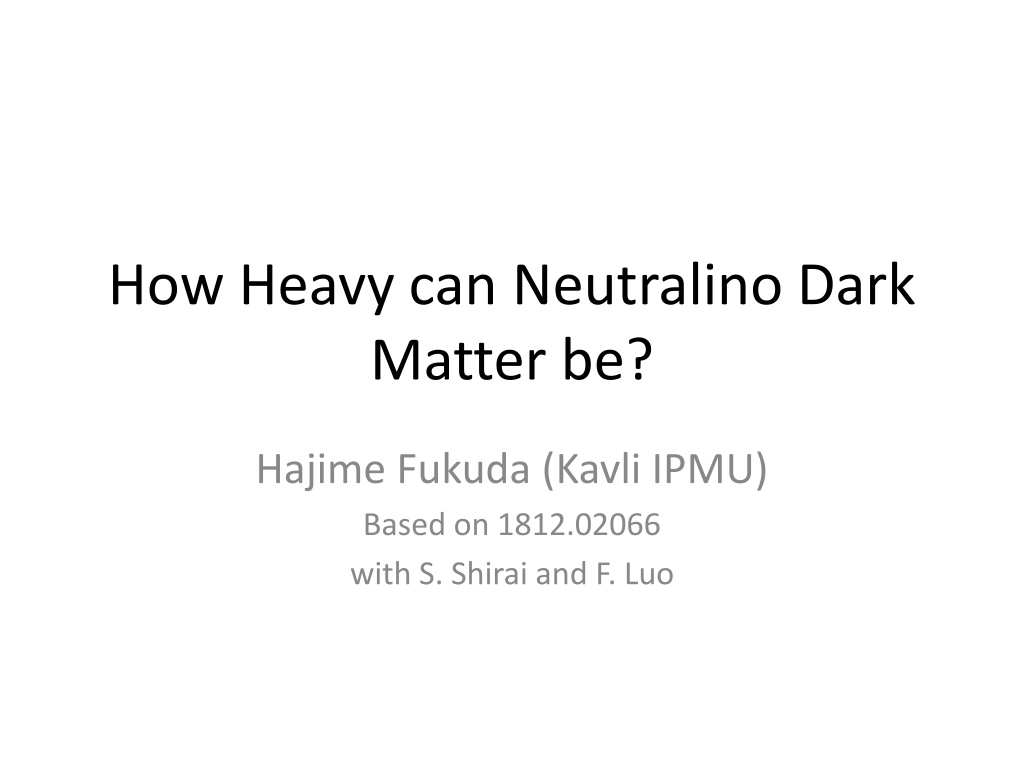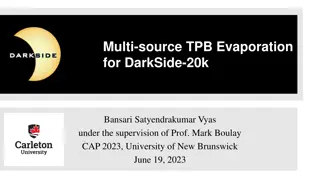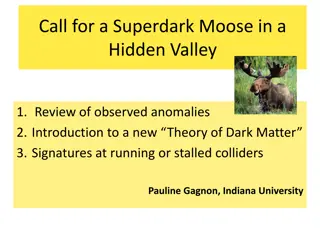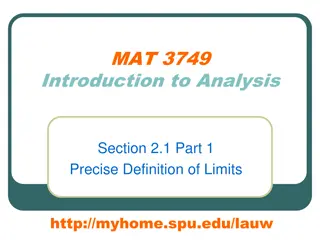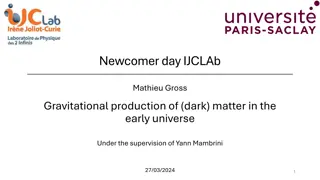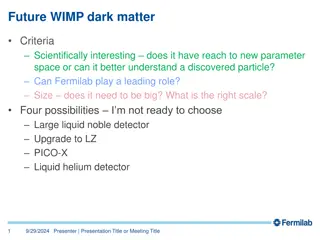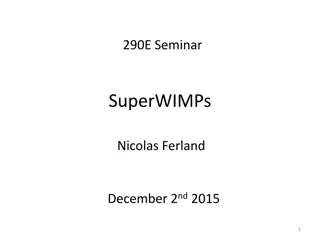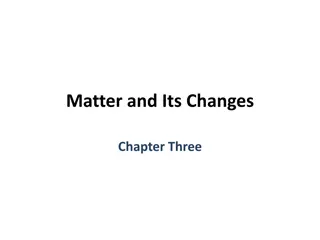Exploring Neutralino Dark Matter Mass Limits
Hajime Fukuda, along with researchers Shirai and Luo, conducted a study on the maximum mass of Neutralino dark matter particles. They investigated coannihilation effects and how colored sparticles can enhance LSP annihilation. The study delves into the implications for TeV-scale supersymmetry models like MSSM and the constraints imposed by the WIMP Miracle 2.0. It also examines the upper bounds for the lightest SUSY particle (LSP) mass in the context of R-parity conservation and dark matter abundance. Through detailed analyses, the research sheds light on the range of permissible masses for Neutralino dark matter.
Download Presentation

Please find below an Image/Link to download the presentation.
The content on the website is provided AS IS for your information and personal use only. It may not be sold, licensed, or shared on other websites without obtaining consent from the author. Download presentation by click this link. If you encounter any issues during the download, it is possible that the publisher has removed the file from their server.
E N D
Presentation Transcript
How Heavy can Neutralino Dark Matter be? Hajime Fukuda (Kavli IPMU) Based on 1812.02066 with S. Shirai and F. Luo
Outline Introduction Coannihilation Coannihilation through the brown muck
TeV scale supersymmetry (SUSY) Minimal SUSY SM (MSSM) at TeV scale has many motivations Naturalness (?) Coupling unification Dark matter
Is MSSM getting unfavored? MSSM parameter regions easy to see @ LHC is getting unfavored ATLAS Summary Plot
Is there a goal for SUSY search? We can impose an upper bound for the lightest SUSY particle (LSP) mass If R-parity is conserved, so that the LSP is DM LSP abundance is given by thermal freeze-out Once the Universe is hot enough and the LSP is in the thermal bath
Why does an upper bound exist? WIMP Miracle 2 0.110 26cm3/s ?? For too large LSP mass, ?? is too small and 2 is too large It s quite important to clarify the upper bound of ?? to get the LSP mass upper bound
Coannihilation Color Neutral LSP Candidates: ?, ?, If a colored sparticle helps LSP annihilation, effective ?? is much enhanced Coannihilation
Mass spectrum Mass ? or ? Mass difference is less than about ??????? ???? 30 LSP
How is LSP Annihilation Enhanced? Amount /d.o.f. @ ? ??????? ? or ? LSP
How is LSP Annihilation Enhanced? Amount /d.o.f. @ ? ??????? ? or ? LSP
How is LSP Annihilation Enhanced? Amount /d.o.f. @ ? ??????? Scattering with ? or ? ? or ? LSP
Mass bound by pert. coannihilation Bino LSP coannihilation with gluino 8 TeV with squark 2 TeV See e.g. Ellis, Luo, Olive 15 Ibarra et al. 15 (Non-perturbative effect of QCD) Can we go beyond this? Use of brown muck Assume bino LSP and degenerated right handed squark Gross et al. 18 HF, Luo, Shirai 18
COANNIHILATION THROUGH THE BROWN MUCK
Brown muck Kang et al. 06 If the squark lives after the QCD PT, the quark/gluon cloud surrounds it (brown muck) 1 ? ??= ??
Brown muck collision Kang et al. 06 ????? ? ????? ?/? ? 2 ? 1/? ?? ? ? ??/????? ? ? ? ?(1)????? ?????
Brown muck collision Kang et al. 06 Brown mucks form a bound state with ? ? ? ?? 2 Thus, if the bound state decays soon, the effective DM annihilation cross section is ????? ?? ?? 2 ????? Large annihilation?
Bound state decay Kang et al. 06 Bound state doesn t decay immediately Due to the small overwrap of the wavefunctions ? ? ? ?? ? ? ?? ? ? TeV ? ? ?? 10
Fate of the bound state Eventually, it deexcites into the ground state and annihilates efficiently Tracking the deexcitation process is essential to estimate ?????
Deexcitation & Destruction During deexcitation, squarkonium can also be broken by squark decay/particle collision In total, the effective annihilation cross section for the squark is ????? ?????+ ???? 2 ? ?? ??
Deexcitation process Dipole emission Collision b/w pion/photon Boltzmann supp. for pion
Destruction process Decay (& collisional decay) Collision
Annihilation efficiency ????? ?????+ ????
Chemical Equilibrium Difficult to maintain!
Chemical Equilibrium Boltzmann suppression for meson is large Weak interaction is too weak
Result For bino LSP
Detection Direct detection is effective
Summary Using QCD non-perturbative effect, the DM mass can be as heavy as 300 TeV Since the squark and bino is highly degenerated, the direct detection is effective for light flavor squarks
Difference b/w Strumias group They didn t consider the confinement effect It seems that they simply extrapolate the perturbative treatment of the bound state They didn t consider chem. eq.
What if for other NLSP? Left-handed squark NLSP d.o.f is larger Up and down type squarks are degenerated Gluino NLSP Chem. eq. is hard to maintain The squark must be light No Larmor radiation
What if for other LSP? Wino LSP d.o.f is larger Higgsino LSP d.o.f is larger Chem. eq. w/ gluino can be achieved by ?(100 TeV) squark & gluino ?
